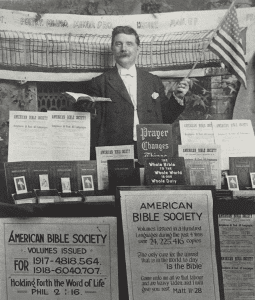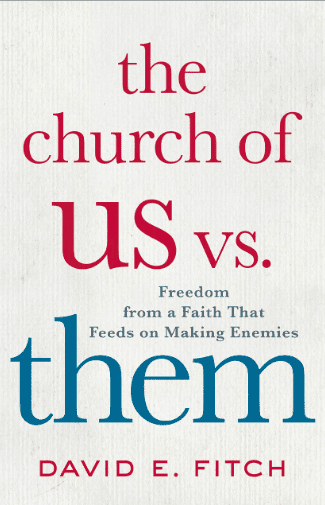 The United States of America chose intelligently and rigorously not to have a national religion/faith. American Christians have not been so rigorous, even if intelligent. Instead of a national religion we have Americans of all persuasions seeking to express their viewpoints and claims and, at the same time, using the political process to implement those persuasions for the nation — even if only slightly cleverly disguised. Both Republicans and Democrats think their agendas and platforms are the most Christian while many leaders avoid partisan politics from the pulpit (many don’t) while they use the same to announce which moral issue points to which political party. We don’t have a national religion but instead religionists who want it to go national.
The United States of America chose intelligently and rigorously not to have a national religion/faith. American Christians have not been so rigorous, even if intelligent. Instead of a national religion we have Americans of all persuasions seeking to express their viewpoints and claims and, at the same time, using the political process to implement those persuasions for the nation — even if only slightly cleverly disguised. Both Republicans and Democrats think their agendas and platforms are the most Christian while many leaders avoid partisan politics from the pulpit (many don’t) while they use the same to announce which moral issue points to which political party. We don’t have a national religion but instead religionists who want it to go national.
Enter the Bible, and in particular, the American Bible Society, and it should not take long to see in the picture to the right an open Bible in one hand and American flag in the other. A recent and exceptional book by John Fea, called The Bible Cause: A History of the American Bible Society, tells this story through one institution — the American Bible society — but in so doing Fea demonstrates the constant intersection of Bible and nation building. I recommend this book for all churches and for all schools, colleges and universities. The impact of the ABS is of magnitudes and often enough totally unknown. Fea is an exceptional historian of the church in America. His expertise in connecting ABS to American church history is all over this book.
Before I begin this: those who read the New Testament in Greek or the Old Testament in Hebrew or the Septuagint in Greek read from an ABS or United Bible Societies produced edition. Many of the most important tools used in Bible studies today were produced by or in cooperation with the ABS.
Every major translation of the Bible today translates the Hebrew and Greek texts produced in conjunction with ABS and UBS. This alone justifies the importance of knowing the story told by Fea.
Even more, the proliferation of translations of the Bible throughout the world among those who have no Bible is often the result of ABS/UBS efforts.
Many churches, many institutions, many homes are stocked with Bibles that come from the ABS.
Fea tells a long and detailed story but my point is not just that story, which I will summarize quickly, but to highlight emphases in the story of the ABS that illustrates US church history and the politics of American Christianity today. Here is the big picture — ABS was originally evangelical, became far more mainline in the 20th Century, and at the present has shifted back to the evangelical. Here is Fea’s summary:
Moreover, the ABS, as a national Bible society would continue to try to position itself at the center of American culture. In the nineteenth century, the ABS was an evangelical benevolent society in an evangelical culture. For most of the twentieth century the ABS gravitated to the cultural power of the historic Protestant mainline. Today in a much more heterogeneous American society where there is no one manifestation of Christianity with the power to shape the culture in the way that evangelicals did in the nineteenth century and the Protestant mainline did in the twentieth century the ABS has decided to work most closely with institutions, organizations, and communities that have strong evangelical sympathies (310).
There is not a little bit of politics at work in both translations and in the distribution of Bibles. Now to some summary observations:
First, from the beginning the mission of the ABS was (1) to distribute Bibles for the purpose of redemption and (2) only through the Bible could America become the nation God wanted it to be. As Fea puts it, “God and country.”
Over the years, ABS has had one plan after another to distribute a Bible in every home in the USA. It sells Bibles and it generates donations and distributes many Bibles free.
Second, the big picture of ABS: First, the American Bible Society has always been a Christian organization that is interdenominational in scope. Second, the American Bible Society has always sought to work from a position of religious and cultural power in the United States. Third, the American Bible Society has always been at the forefront of innovation, both in American Christianity and the nation as a whole. Fourth, the American Bible Society has struggled over the years to define its organizational identity (points from p. 6).
Third, it settled for some time as a Protestant organization and has had over time difficulty in its relationship to the Roman Catholic Church. Its more recent shift has been toward the evangelical wing of the American church, and some of Fea’s descriptions reveal some political maneuvering for control. The mission shifted slightly from distribution to experiencing the Bible’s life-changing message.
Fourth, social movements and crises generate special needs for Bibles: slaves (a Bible for all slaves, but slaveowners didn’t want that message getting to the slaves, so ABS formed a separate organization for slaves and Southern African Americans after the Civil War), the Civil War (a Bible for both sides, peace comes by following the Bible), immigration (a Bible for as many as possible because it alone can bring redemption and national unity), other countries (establish Bible Society Bibles for each language in the world — Middle East, China, Mexico), WW1, WW2, Viet Nam (soldiers need Bibles), post WW2 Germany (the Bible is the answer for Germans).
Fifth, ABS produced a Bible of its own: originally in the NT called Good News for Modern Man, and then later the whole Bible in The Good News Bible (TEV). Both were criticized heavily by fundamentalist evangelicals (a not uncommon feature of fundamentalist evangelicals when new translations appear) but they have been distributed in the millions and millions.
When it was released in September 1966, Good News for Modern Man was a cultural phenomenon. It was one of the most successful religious publications in American history. Good News was the New Testament translation of the ABS-inspired Today’s English Version (TEV [today called the Good News Translation, or GNT]). For the price of a quarter, the English-speaking public (and eventually the world) could read the Bible in language that the ABS said was “as fresh and immediate as the morning newspaper.” While the Society had been translating, publishing, and distributing the King James Version and the Revised Standard Version for decades, Today’s English Version was its first attempt at creating its own English-language translation of the Bible (254).
Sixth, speaking of which, behind the ABS Bibles was Eugene A. Nida who developed a theory of translation called “dynamic equivalence,” which aims at a translation that evokes the same response in the current audience that was evoked in the original audience. Fea tells the story of Robert Bratcher, a story of a head translation theorist who protested when many wanted a translation (Good News Bible) that was more sensitive to the church-reading public in the USA and who eventually resigned over the issues.
Finally, ABS has had one large mission — to distribute Bibles — and what will encourage that has been done time and time again. It has time and time again avoided theological strife and denominational battles and sought instead to get the Bible into the hands of as many people as possible.
I have three friends who work for ABS: Phil Towner and Roy Ciampa in the Nida Institute, and Jason Malec who works with Bible distribution and experiencing its message.










